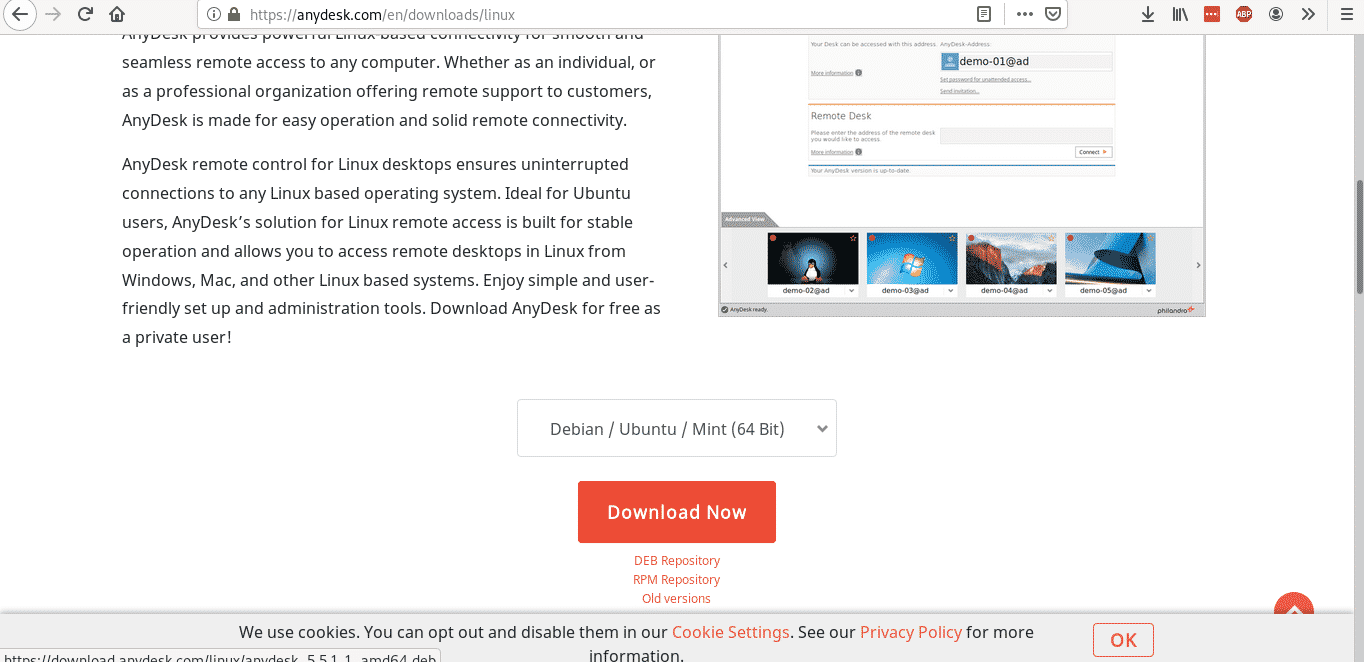- Install Anydesk By Terminal
- Install Anydesk Using Terminal Ubuntu 16.04
- Install Anydesk For Windows 10
- Install Anydesk Linux Terminal
Now Install AnyDesk on RHEL 8 or CentOS 8 after the AnyDesk repository has been added to the system. S udo dnf makecache sudo dfn install -y redhat-lsb-core sudo dfn install anydesk. Agree to import the GPG key by selecting ‘y’ from the received terminal prompt. This step will initialize the installation of AnyDesk on RHEL 8 / CentOS 8. AnyDesk for Linux, is easy to install. License: Freemium for private individuals. How to install: Begin by downloading the software here. Open a terminal window: cd downloads. Sudo dpkg -i anydesk2.9.5-1amd64.deb. Enter, sudo apt-get install -f Developers website.
The command line provides a tool to automate AnyDesk using scripts. For some cases AnyDesk uses the pipe mechanism of the operating system instead of parameters for higher security.
See also: Exit Codes, Automatic Deployment
Automatic Execution (script)
AnyDesk can be installed by script with the following command:
anydesk.exe --install <location> --start-with-win
Important:

<location> must be a valid installation path, e.g. c:anydesk. Currently, AnyDesk must be startedwith Windows.
For more installation parameters, see Automatic Deployment.
Initialization Parameters
| Parameter | Description |
--control | Start the process which creates the tray icon. During installation, AnyDesk creates a link with this parameter in the autostart start menu entry (for Windows only). |
--tray | Start the process which creates the tray icon (for Windows only). |
--start-service | Start the AnyDesk service, if not already running (for Windows, Administrator privileges required). |
--service | Start the AnyDesk service, if not already running (for Linux). |
--stop-service | Stop the AnyDesk service. |
--restart-service | Restart the AnyDesk service. |
--silent | AnyDesk will not display message boxes when this parameter is specified. Recommended for scripts. |
--remove | Uninstall AnyDesk with no notice (silent uninstall). |
Get Alias, ID, Status or Version
AnyDesk writes requested information to stdout.If the service is not running, SERVICE_NOT_RUNNING is returned and an exit is set indicating the error. If AnyDesk is not installed, it needs to be started first, in order to launch a local service.
On Linux, get AnyDesk Alias or ID of the installed and running AnyDesk, with this syntax:
anydesk --get-alias
anydesk --get-id
anydesk --get-status
anydesk --version
Use batch scripts for Windows:
to get ID:
to get Alias:
to get status:
to get version:
Setting a Password
For security reasons, a password for unattended access can not be set from the command line directly as this would enable malicious users to spy the password from the command line in Task Manager. Instead, a pipe is used to set the password.
echo password | anydesk.exe --set-password
Examples:
Standard client: echo my_new_password | anydesk.exe --set-password
Custom client: echo my_new_password | anydesk-123abc456.exe --set-password
This requires administrator privileges.
Removing the Password (for Windows only)
A non-preset unattended access password can also be removed from the AnyDesk client using the command line.
Examples:
Install Anydesk By Terminal
Standard client: anydesk.exe --remove-password
Custom client: anydesk-123abc456.exe --remove-password
This requires administrator privileges.
Registering License Key

You can register a license with the current AnyDesk installation using the command line. The service must be running.
echo license_keyABC | anydesk.exe --register-license

Almost every scripting language has a pipe interface for stdin and stdout. See the programming language documentation for more information.
Connection Parameters
To connect to a remote AnyDesk ID or Alias, the syntax is: anydesk.exe alias@ad

The following commands can be added after the destination address (for Windows only):
--file-transfer | Start the file transfer session. |
--fullscreen | Start a session with fullscreen mode. |
--plain | Start a plain session, without window title and toolbar. |
Connecting with Password (for Windows only)
Example script that connects to alias@ad with password.Use command line or batch script:
Install Anydesk Using Terminal Ubuntu 16.04
echo password | 'C:Program Files (x86)AnyDeskAnyDesk.exe' alias@ad --with-password
Other Command Lines (for Windows only)
Open the Settings window:
Install Anydesk For Windows 10
--settings | or |
--admin-settings | (for global settings) |
Install Anydesk Linux Terminal
To go to the specific setting page, the syntax is:
--settings: | ui (User Interface) |
security | |
alias (Setup Alias panel) | |
privacy | |
video (Display) | |
capture (Windows 7 only) | |
audio | |
connection | |
file_transfer | |
recording | |
printer | |
wol (Wake-On-LAN) | |
license (License Key) | |
about (About AnyDesk) |
To open global settings:
--admin-settings: | capture (Windows 7 only) |
security | |
connection | |
recording |
--plain | Open a plain AnyDesk window. Can be used with AnyDesk connection command. |
--disclaimer | Show your customized disclaimer |
--show-advert | Show the advertisement page of AnyDesk. Thank you for sharing! :) |
